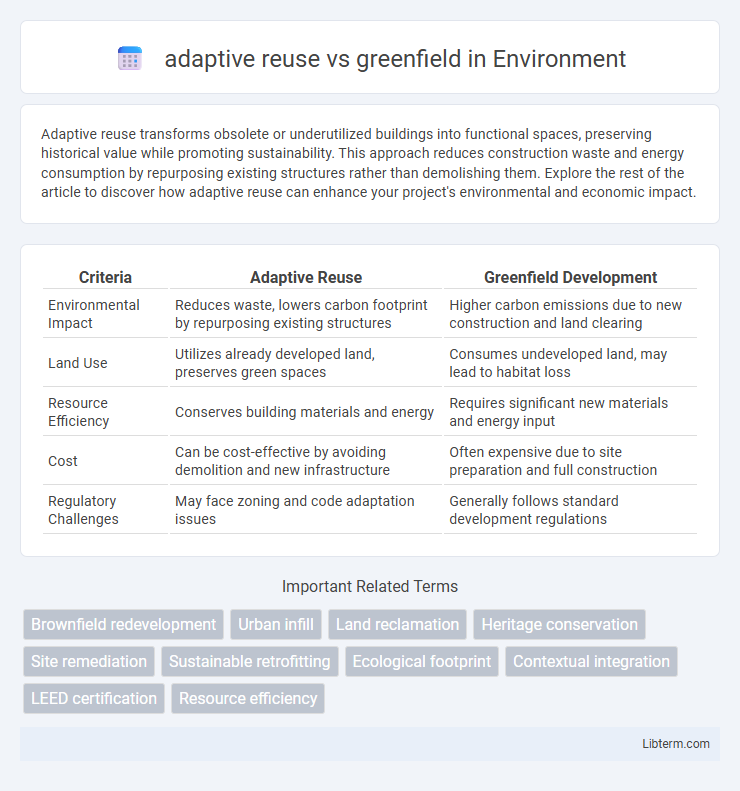Adaptive reuse transforms obsolete or underutilized buildings into functional spaces, preserving historical value while promoting sustainability. This approach reduces construction waste and energy consumption by repurposing existing structures rather than demolishing them. Explore the rest of the article to discover how adaptive reuse can enhance your project's environmental and economic impact.
Table of Comparison
| Criteria | Adaptive Reuse | Greenfield Development |
|---|---|---|
| Environmental Impact | Reduces waste, lowers carbon footprint by repurposing existing structures | Higher carbon emissions due to new construction and land clearing |
| Land Use | Utilizes already developed land, preserves green spaces | Consumes undeveloped land, may lead to habitat loss |
| Resource Efficiency | Conserves building materials and energy | Requires significant new materials and energy input |
| Cost | Can be cost-effective by avoiding demolition and new infrastructure | Often expensive due to site preparation and full construction |
| Regulatory Challenges | May face zoning and code adaptation issues | Generally follows standard development regulations |
Introduction to Adaptive Reuse and Greenfield Development
Adaptive reuse involves repurposing existing buildings or sites to meet new functional needs, preserving cultural heritage and reducing environmental impact by minimizing demolition and construction waste. Greenfield development refers to building on previously undeveloped land, offering design flexibility but often leading to habitat disruption and increased resource consumption. Evaluating site conditions, sustainability goals, and community impact plays a critical role in choosing between adaptive reuse and greenfield development strategies.
Key Definitions: Adaptive Reuse vs. Greenfield
Adaptive reuse involves repurposing existing buildings or structures for new uses, preserving historical elements while minimizing environmental impact by reducing construction waste. Greenfield development refers to building on undeveloped land, often agricultural or natural areas, offering greater design flexibility but higher environmental costs due to land disturbance and habitat loss. Understanding these key definitions highlights trade-offs in sustainability, cost, and project scope between reusing built environments and developing virgin sites.
Environmental Impacts of Adaptive Reuse
Adaptive reuse significantly reduces environmental impacts by minimizing construction waste and conserving natural resources compared to greenfield developments. Utilizing existing structures lowers carbon emissions associated with demolition and new material production, contributing to sustainable urban growth. Energy savings from repurposing buildings support reduced greenhouse gas emissions and lessen the overall ecological footprint of development projects.
Sustainability Benefits of Greenfield Projects
Greenfield projects offer sustainability benefits by enabling the implementation of modern, energy-efficient designs and renewable energy systems from the ground up, minimizing legacy waste and infrastructure constraints. These developments can incorporate advanced water management and green space planning, reducing urban heat island effects and promoting biodiversity. Furthermore, greenfield sites often allow for better integration of sustainable transportation options, lowering long-term carbon footprints compared to retrofitting older structures.
Cost Considerations: Reuse vs. New Construction
Adaptive reuse projects often present lower overall costs compared to greenfield developments due to reduced material requirements and shorter construction timelines. Renovating existing structures minimizes expenses related to land acquisition, site preparation, and infrastructure installation typically necessary in new construction. However, unforeseen issues in older buildings, such as asbestos removal or structural repairs, can increase costs, making thorough initial assessments crucial for accurate budgeting.
Regulatory and Zoning Challenges
Adaptive reuse projects often face complex regulatory and zoning challenges due to the need to retrofit existing structures to meet current building codes, historical preservation requirements, and land-use regulations. Greenfield developments typically encounter fewer zoning obstacles as they involve building on undeveloped land, allowing for more straightforward compliance with modern planning standards and infrastructure implementation. Navigating the intricacies of permits, variances, and environmental impact assessments significantly influences project timelines and costs in both adaptive reuse and greenfield developments.
Community Impact and Social Value
Adaptive reuse projects preserve community identity by revitalizing existing structures, fostering local pride, and maintaining neighborhood character, which enhances social cohesion and engagement. In contrast, greenfield developments often disrupt established communities by introducing new infrastructure on undeveloped land, potentially leading to displacement, loss of cultural heritage, and extended commuting times. By prioritizing adaptive reuse, urban planners can promote inclusive community growth while reducing environmental footprints and supporting sustainable social value.
Design Flexibility and Architectural Potential
Adaptive reuse projects offer significant design flexibility by allowing architects to creatively reinterpret existing structures, preserving distinctive architectural features while integrating modern functionalities. In contrast, greenfield developments provide a blank canvas, enabling unlimited architectural potential through customized layouts and innovative building techniques without constraints imposed by pre-existing frameworks. Balancing adaptive reuse's preservation benefits with greenfield's expansive design options supports sustainable urban development strategies.
Long-Term Maintenance and Lifecycle Analysis
Adaptive reuse projects often demonstrate lower long-term maintenance costs due to the preservation and modification of existing structures, which benefit from established materials and construction techniques. Lifecycle analysis reveals that adaptive reuse significantly reduces embodied energy and carbon emissions compared to greenfield development by minimizing the need for new raw materials and construction waste. Greenfield sites typically require extensive infrastructure installation and new building materials, resulting in higher lifecycle environmental impacts and maintenance demands over time.
Choosing the Right Approach: Factors to Consider
Choosing between adaptive reuse and greenfield development depends on factors such as project location, environmental impact, and cost efficiency. Adaptive reuse preserves existing structures, reduces material waste, and often accelerates project timelines, making it ideal for urban areas with historical significance. Greenfield projects allow for customized design and modern infrastructure but require more extensive land development and may have higher environmental footprints.
adaptive reuse Infographic

 libterm.com
libterm.com